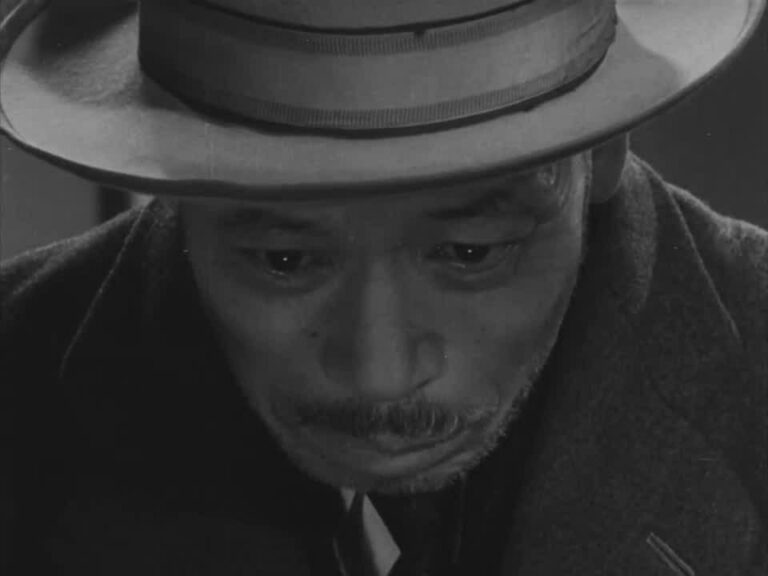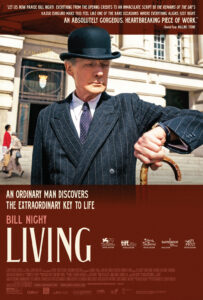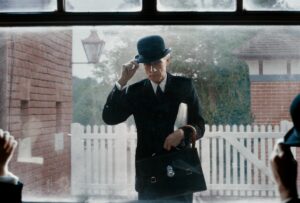Ikiru (1952) | Directed by Akira Kurosawa | Written by Kurosawa, Shinobu Hashimoto and Hideo Oguni | 143 min | ▲▲▲▲△ | Criterion Channel
Living | Directed by Oliver Hermanus | Written by Kazuo Ishiguro, an adaptation of Ikiru, a film by Akira Kurosawa | 104 min | ▲▲▲▲△ | Crave
I was familiar with Akira Kurosawa’s samurai and war epics, but this early 1950s picture is something else entirely. Ikiru is about a lifelong bureaucrat, the sad-faced, stooped Kanji Watanabe (Takashi Shimura), working as a Section Chief in an office surrounded by towers of paper and sullen functionaries. He lives with his son and daughter-in-law who don’t seem to care much for him.
Watanabe’s doctor tells him he has stomach cancer. Faced with his imminent mortality, he struggles to assess the purpose of his life, frustrated with years of professional inertia. He looks for escape with a writer (Yūnosuke Itō), who shares with him the pleasures of a bacchanalian nightlife. It doesn’t really do much for him. In a bar he sings a song, “Life Is Brief,” while weeping.
Watanabe becomes friendly with an enthusiastic younger woman from his office, Toyo (Miki Odagiri) while he takes time away from work. Her example inspires him to make something of himself with the time he has left, while their friendship scandalizes his son and daughter-in-law.
Kurosawa’s film is about the danger of stultifying bureaucracy in Japanese society, but it also applies a gentle lesson about appreciating life’s fleeting beauty. As Andy Dufresne once said, “Get busy living or get busy dying.”
It’s a solidly impressive film — with a structural twist that you don’t see often, jumping forward in time so the last act is peppered with flashbacks and told through the eyes of the supporting cast. I think it’s fair to say the remake, which deftly adapts the best moments from the Japanese film, might be even better than the original.
Hermanus and Ishiguro shift the setting to London, but also in the 1950s. The Brits’ deep repression and rule-following means the Watanabe character, now named Mr Williams (Bill Nighy, Oscar nominated for this role and entirely deserving), doesn’t have any blow-up fights with his son and never weeps openly. It’s somehow a more lyrical film for the way his secrets are kept, and so much of it is in his performance.
Mr Williams is a Public Works manager who inspires fear and respect in his subordinates, including Wakeling (Alex Sharp) and Margaret Harris (Aimee Lou Wood).
When Williams finds he has a terminal illness, he starts to reassess the purpose of his life. He takes a few days off and meets a man in a seaside town (Tom Burke) who shows him a good time — but debauchery doesn’t seem like the answer. Nighy does get a moment to sing (here it’s a Scottish folk song). It’s a lovely moment, and perhaps the first time Nighy has lifted his voice on screen since Love Actually, or maybe The Boat That Rocked.
The film spins an utterly gorgeous look, starting with terrific use of archival footage of London in opening credits. Cinematographer Jamie Ramsay utilizes a palette of deep saturated colours, the blues in the woollen, pin-striped suits (costumes by Sandy Powell), the darkness in silhouette, and a hypnotic, a soft glow around lights.
As with Ikiru, our doomed bureaucrat gets to know a young woman. In Living it’s Miss Harris, someone whose joi de vivre he admires, and it is her example that spurs him to action.
There’s a joyous moment where Williams and his new friend are at the cinema and it looks like the light from the projector is coming out of his head. And the score, a mix of contemplative piano and strings by Emilie Levienaise-Farrouch completes the spell.
This is an elegiac story of passion overcoming apathy, with Ishiguro’s script mirroring Kurosawa’s structural twist late in the running, allowing each of the supporting cast a moment to address the mysteries of Williams’ final acts.
It’s a beautiful, moving picture, with just the right touches of humour and pathos in amongst the melancholy. It’s a must-see in cinemas.
A capsule version of this review appeared on the blog in September 2022 during the coverage of the Toronto International Film Festival.



















